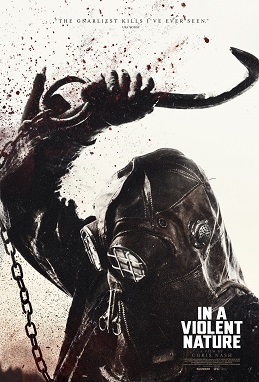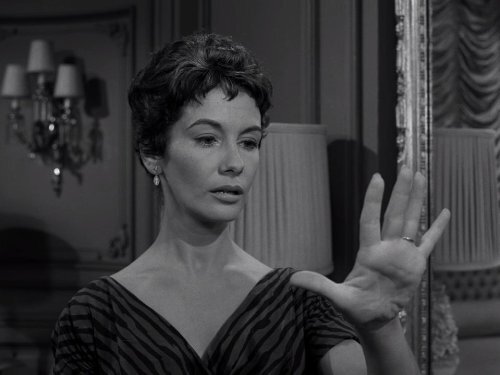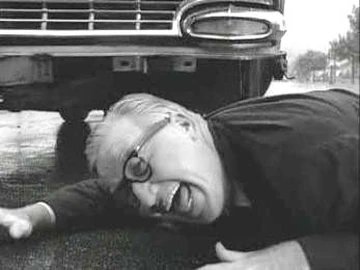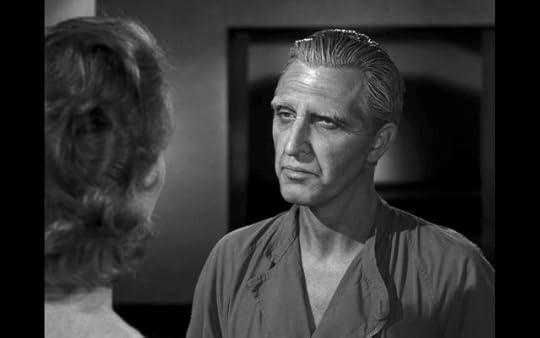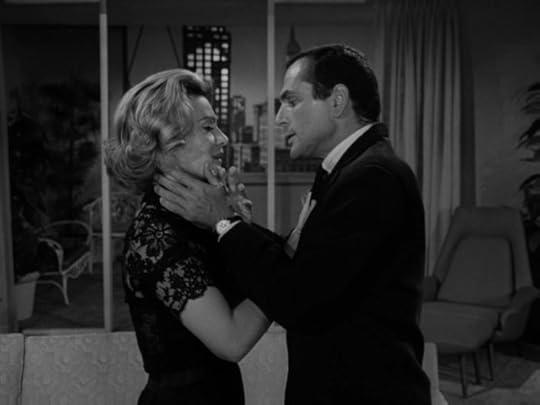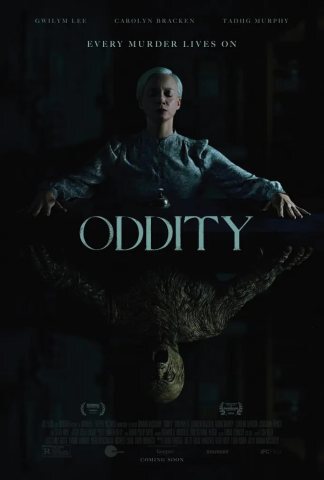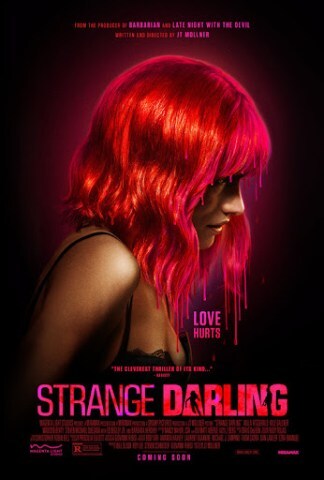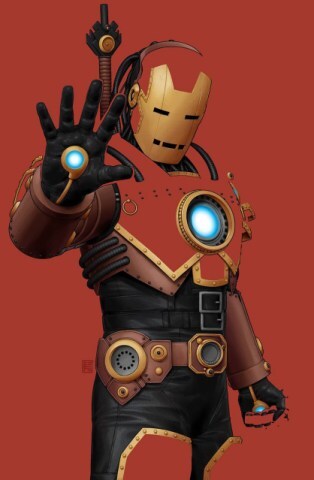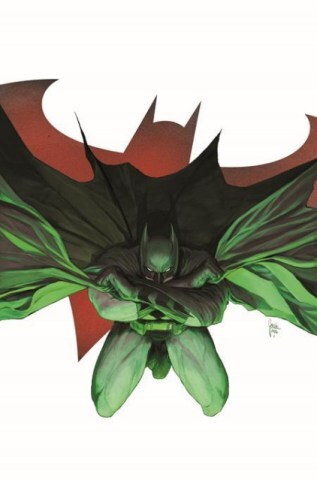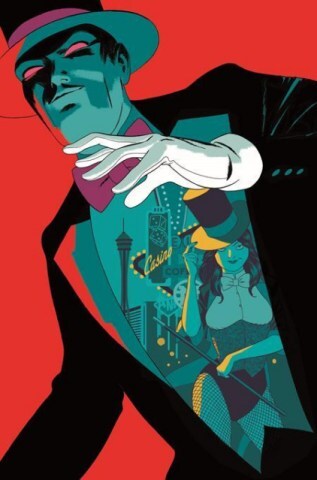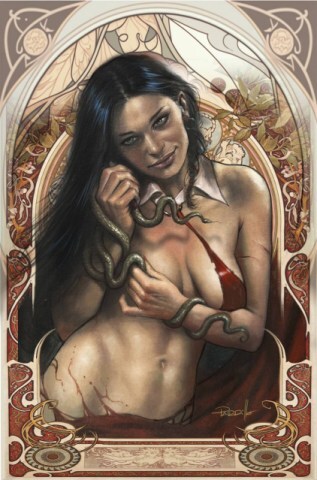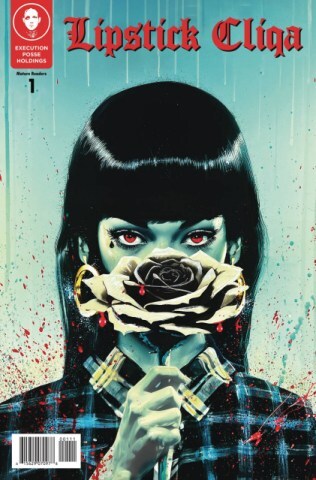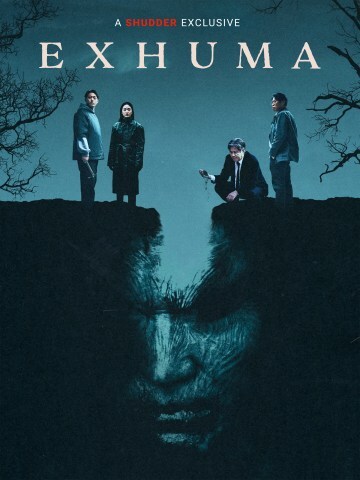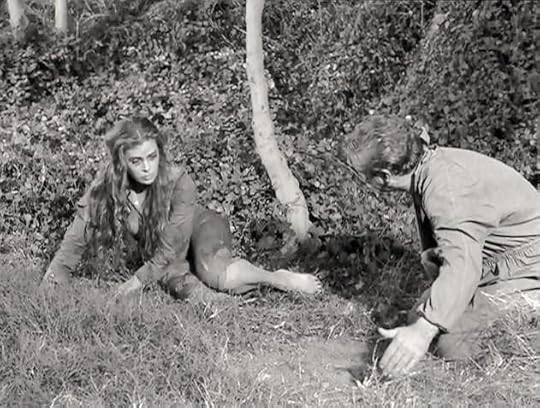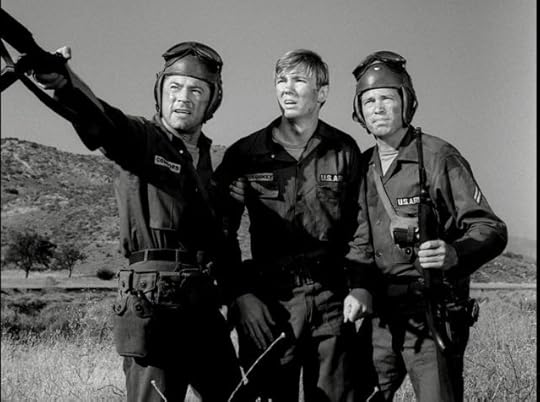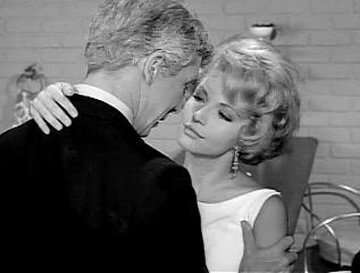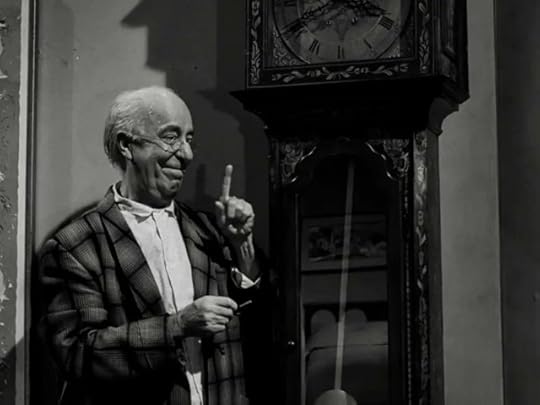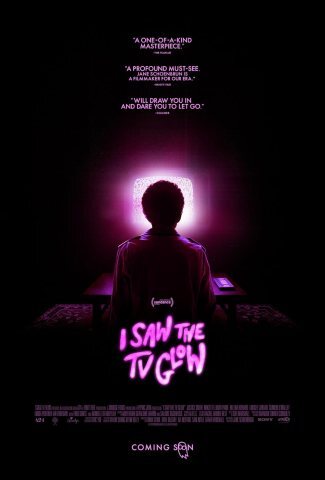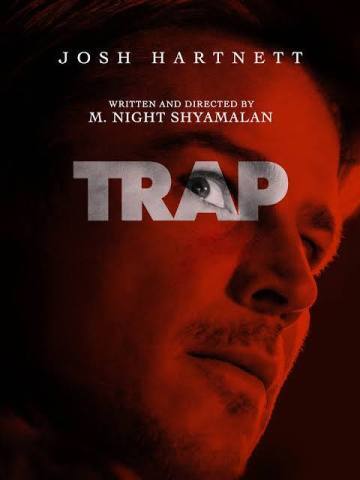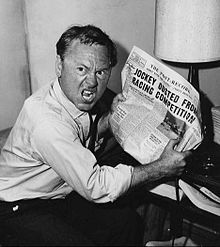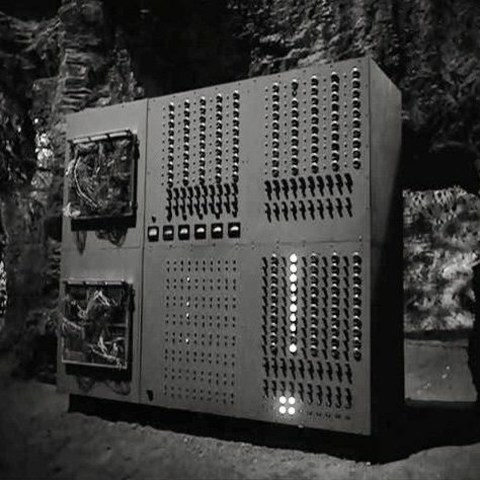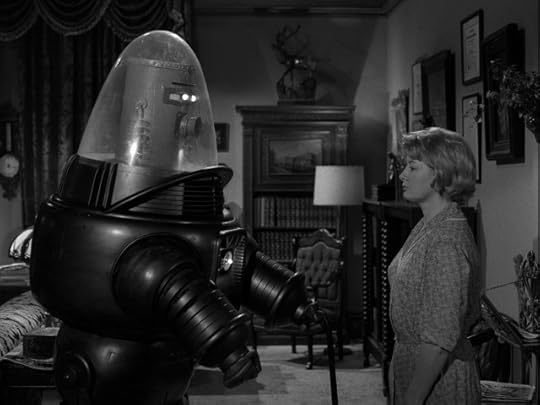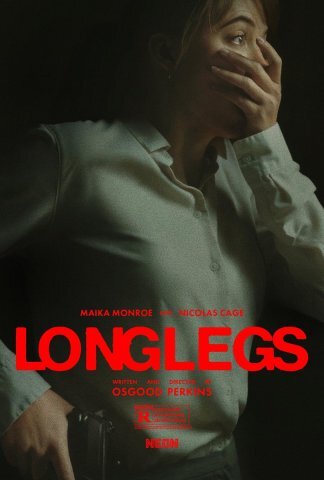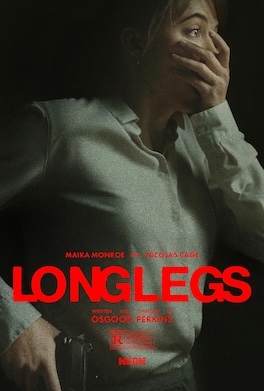Joseph Mallozzi's Blog, page 38
October 27, 2024
October 27, 2024: Sharky Sunday! And our 13 Days of Halloween countdown continues with…In A Violent Nature!
Sharky Snacks – Crunchy- O’s edition…

New trick: Paw!

Halloween Fashion Show #1…

Halloween Fashion Show #2…

Wizarding school…

Practicing his spells…

Out and About with Sharky: Back to Tiny Market…

Continuing our 13 Days of Halloween countdown with…Movie #10: In A Violent Nature
Despite a few directorial flourishes, this just feels like the filmic equivalent of Friday the 13th fan fiction.
1.5/5 Jack o’ Lanterns
The post October 27, 2024: Sharky Sunday! And our 13 Days of Halloween countdown continues with…In A Violent Nature! appeared first on Joseph Mallozzi's Weblog.
October 26, 2024
October 26, 2024: The Montreal Update! The 13 Days of Halloween countdown continues with The First Omen!
A promising update from Montreal via sis. Mom finally went in and had her full epidural. It was a painful process for her but, days later, she is finally walking (somewhat) and even doing stairs. Yesterday, my sis took her for an outing – a trip back home to visit the dogs!
On the road again.
All smiles, back home.
The doctor says that if she continues to show improvement, she will be discharged on Monday. But that also means that she will be without nurses’ supervision so I may be heading back to Montreal for a few days. We’ll see…
Hey, are you all keeping up with the 13 Days of Halloween Countdown? A horror movie a day ’til Halloween. Today, it’s Horror Movie #9: The First Omen
A delightfully sinister, surprisingly effective prequel that delivers the carnage and ecclesiastical conspiracy in equal measure.
4/5 Jack o’ Lanterns
The post October 26, 2024: The Montreal Update! The 13 Days of Halloween countdown continues with The First Omen! appeared first on Joseph Mallozzi's Weblog.
October 25, 2024
October 25, 2024: The Twilight Zone rewatch continues with season 5, episodes 13-16! And our 13 Days of Halloween countdown continues with…Oddity!
Season 5, Episode 13, “Ring A Ding Girl”
This episode first aired December 27, 1963.
The house set was previously used in “Living Doll” (1963)
At one point in the episode, Bunny says to her sister: “Remember when we used to lie in bed on rainy nights and call to each other when we were kids?”. The writer of this episode, Earl Hammer Jr., was inspired here by his own upbringing when he and his seven siblings would call out to each other every night at bedtime. And this would become the iconic closing of The Waltons (1972), a show Hamner would later create.
Maggie McNamara, who played Bunny Blake, wanted to be a fashion designer. She was offered a movie contract by David O’Selznick but turned it down in favor of taking acting classes and doing plays. She landed on Broadway and was eventually offered a lead role in The Moon is Blue (1963) by director Otto Preminger. The role earned her rave reviews and an Oscar nomination. She signed a contract with 20th Century Fox but angered the studio by refusing to do cheesecake publicity photos. Following an affair with Richard Burton, her marriage fell apart and she suffered a nervous background. Unable to find steady work onscreen, she worked as a typist and wrote a film script that was optioned by a studio. McNamara suffered from depression, however, and took her own life at the age of 48.
David Macklin, who played Bud, was quite vocal about how much he disliked working on this episode: “First of all I didn’t care for the script or my character. I was getting much bigger parts. But it was slow and I went for the money. My first experience was make-up where some old hack gave me the worst make-up I have ever experienced. It seemed he didn’t think I was important enough to give the kind of make-up he did on Maggie and Mary. Maybe he didn’t have time after doing them and thought he would catch up not he kid. Anyway, he simply smeared pancake all over my face including my mouth, eyelashes, and brows. I had the sense to remove the make[up from those areas but I still looked lousy. It was that show that taught me to bring my own make[up to the set.” Macklin continued: “Then I went to wardrobe and they dressed me in the worst shirt ever seen on television. That was also taught me to be more discriminating about wardrobe. Mr. Grossland was aloof and gave no help or encouragement. In fact I think his coverage of the final scene stinks. I didn’t get a reaction shot and should have. On the positive side, Maggie and Mary were a delight to work with and I loved that car. Poor Maggie, she had to wear that one dress through the whole show and they never cleaned it. It was getting a little ripe bear the end. I had no idea, at the time that I was working on a classic TV show that a lot of people would like the segment. I certainly had no idea it would rerun so much. I wouldn’t be surprised if it were the most run TV show ever… And I receive no residuals, bah! Ironically, I didn’t know at the time that I would get more mail for this program than any other.”
Bing Russell, who played Ben Braden, was the father of Kurt Russell.
Betty Lou Gerson, who played Cici, was the voice of Cruella DeVille in 101 Dalmations (1961).
Bill Hickman, who played the pilot, was a stunt driver known for his work on Bullitt (1968) and The French Connection (1971).
Hank Patterson, who played Mr. Gentry, portrayed the character of Fred Ziffel in three different series: The Beverly Hillbillies (1962), Petticoat Junction (1963) and Green Acres (1965). While shooting the latter, he was already in his 70’s and hard of hearing, but the production worked around his impairment by having the someone lie on the floor, out of camera frame, and tap Hank’s leg with a yardstick as a cue to deliver his line.
This one didn’t really make a whole lot of sense and yet I really liked the Bunny Blake character and the fact that she hadn’t allowed fame to change her. The moment when she hurries out into the rain is haunting and the twist very effective BUT, as I said, the logic doesn’t really track. Presumably she was a time-traveling ghost receiving communications from alternate versions of the people she knew? Wut? I mean, I did enjoy it…yet remain very confused.
Season 5, Episode 14, “You Drive”
This episode first aired January 3, 1964.
Writer Earl Hammer Jr. reflected back on the inspiration for this script: “I believe the genesis of this story came from reading about a child who had been killed by a hit-and-run driver. I guess it was an expression of my anger and a way for me, in fantasy, to bring the guilty party to justice.”
“You Drive” is one of those rare episodes where production ventured off the lot to shoot on actual city streets.
Oliver Pope’s car is a 1956 Ford Fairlane Club Sedan.
To achieve the shot in which the car almost runs over Pope, director George T. Clemens filmed it in reverse, starting with the car parked behind actor Edward Andrews’s head and then backing up. The scene was then reversed and edited into the episode.
This one was kind of weird. It didn’t really feel like a Twilight Zone episode, and I don’t necessarily mean that in a bad way. The cinematography was crisp and the street scenes surprisingly more filmic than previous episodes. I also spent much of the episode trying to place actor Edward Andrews, picking up echoes of a much more nefarious performance – and it wasn’t until I checked imdb that I realized he had played the treacherous Carling in season 1’s “Third from the Sun”.
The killer car thing had been done before, much better in a much worse episode (season 2’s “A Thing About Machines”), but there’s something about this episode, despite it’s straightforward simplicity, that I quite liked. I was initially dubious about Earl Hammer Jr.’s contributions to the show but have to admit I’ve generally enjoyed his episodes.
Season 5, Episode 15, “The Long Morrow”
This episode first aired January 10, 1964.
Serling based his script on “The Gift of the Magi”, a short story by O’Henry in which two poor lovers sacrifice to give each other the perfect give. She cuts off her long hair in order to buy him a chain for his beloved watch while he sells his watch to buy her combs for her beautiful long hair.
This first draft of the script contained a scene in which Stansfield is awakened from his cryo-sleep to perform one of the 131 scheduled interval maintenance checks. Rather than re-enter the stasis pod, he contacts Earth and informs them of his decision not to go back into suspended animation.
Actor Robert Lansing, who played Commander Douglas Stansfield, played Gary Seven in the original Star Trek’s “Assignment Earth”. It was intended to be a pilot for a spinoff series that never got off the ground.
Mariette Hartley, who played Sandra Horn, also guested on class Star Trek as Spock’s love interest Zarabeth in ” All Our Yesterdays”. Hartley was a teenager when she first met Serling: “I was head of the drama club at Staples High School in Westport, Connecticut,” recalled Hartley. “Around the mid-1950s, I saw the ‘Playhouse 90’ episode ‘Requiem for a Heavyweight,’ written by a man called Rod Serling. I was very courageous and gutsy in those days and called him to see if he would speak to our class. He actually answered the phone and said, ‘I’d be delighted.’ I can still see him sitting in the teacher’s desk, with his pipe, at the front of the classroom talking to us. He was so handsome I thought my heart would jump out of my skin! We asked questions and I remember his charm and capacity to include all of us in the discussion.”
Years later, after she began working in Hollywood, Hartley met Serling again. “There was an afternoon I was on the back lot. I cannot recall if Rod Serling was riding in a limousine or in a golf cart between sound stages, but I waved and caught hi s attention. I got him to stop for a moment and introduce myself, and he remembered me. I was bold enough to ask him for a part in a Twilight Zone and he said there might be an opening and get back to me. A few friends were with me at the time and I remember them laughing at me for the stunt I pulled, but I showed them, didn’t I?”
This one was…alright. Another case of the idea being far better than the execution. The idea of these two falling in love over a three hour dinner is preposterous enough and certainly wasn’t helped by Hartley’s emotionally numbing performance. And as soon as they announced she’d been in suspended animation the whole time, my first thought was “Surely he would have known that technology was possible.” She’s the same age as when he left, so it couldn’t have been something developed and launched shortly after his departure. I mean, what a maroon! The best part was at the end when he essentially tells her to go live her life without him and she’s like “Okie doke. See ya later, gramps!”.
This episode landed with a thud for me.
Season 5, Episode 16, “The Self-Improvement of Salvadore Ross”
This episode first aired January 17, 1964.
This was writer Jerry McNeely’s first and only script for the show, an adaptation of a short story by Henry Slesar first published in the May 1961 issue of The Magazine of Fantasy & Science Fiction.
Salvadore’s apartment set was previously used in “A Short Drink from a Certain Fountain”.
A scene that ended up on the cutting room floor had Salvadore visit a bar and trading drinks for a full head of hair for the bald bartender.
Actress Gail Kobe, who played Leah Maitland, recalled: “Director Don Siegel was fast and he was kind. And he would say, “It’s not brain surgery, just relax, Gail.” because I had a tendency to get pretty intense. The cadence of his voice would make you relax, and it just made you better.”
Director Don Siegel, who also directed “Uncle Simon”, had previously directed Invasion of the Body Snatchers (1956) and would go on to direct such notable features as The Killers (1964), Dirty Harry (1971), The Shootist (1976), and Escape from Alcatraz (1979).
It thought this was a pretty good episode until the ending. Like the character in the previous episode, our female lead falls in love with a guy in less than 24 hours. Given Mr. Maitland’s character, I’m not sure what could have convinced him to relinquish his compassion (and, conveniently enough, we never do find out). And why would Salvadore appeal to Maitland’s compassion if he already knows he took it from him? A rather messy end to an otherwise intriguing episode.
And our 13 Days of Halloween countdown continues with,,..
Oddity
Writer-Director Damian Mc Carthy’s first feature, Caveat, was a diabolical descent into Irish horror, and his second feature, Oddity, proves an equally unnerving offering. Calculated and creepy in its slow burn suspense-filledl unfurling.
4/5 Jack o’ Lanterns
The post October 25, 2024: The Twilight Zone rewatch continues with season 5, episodes 13-16! And our 13 Days of Halloween countdown continues with…Oddity! appeared first on Joseph Mallozzi's Weblog.
October 24, 2024
October 24, 2024: Checking out that new temaki place! And the 13 Days of Halloween countdown continues with Strange Darling!
We checked out that new temaki place Akemi has been dying to try. For those of you who don’t know, temaki is a sushi roll where the fish and rice are rolled in nori (seaweed) in the shape of a cone. Hello Nori finally opened its doors within walking distance of our place the other day and so yesterday, after Akemi came back from her annual check-up, we decided to take the five minute stroll over.
The menu is surprisingly not as expansive as I expected but, to be fair, I’m used to frequenting legit temaki joints in Tokyo and this one has more of an L.A. chain feel. We saddled up to the counter and perused the offerings and decided on five temaki each, which I thought would be a lot but turned out to be not quite enough.
Akemi was disappointed in the fish to rice ratio and the construction of the temaki themselves that were lacking the looping nori strip at the bottom to keep the contents from falling out. I found it hard to distinguish the flavors of the different fish. My order of Japanese scallop was the most flavorful because it was heavily seasoned, but I’d argue that if you’re going to season so heavily, why bother with the sweet, delicate flavor of Hokkaido scallops.
After five rolls, I was still hungry and took another look at the menu. While doing so, the manager stopped by and highly recommended the octopus which is cooked sous-vide and then finished on the grill for a delicious char flavor. It sounded delicious and included it in my order – only to have someone inform me moments later that they were out of octopus.
Lunch ended up coming in at a little over $90 (Canadian), but leaving somewhat unsatisfied and slightly hungry.
So I picked up some amaretti and a pistachio croissant for dessert.
Then, today, it was my annual health check. Akemi and I used to go on the same day, but that was before we adopted a puggle with separation anxiety issues. Anyway, after four hours of tests, I celebrated my 2% increase in my lean body mass by picking up a pint of Demetres Double Baked Apple Pie Ic Cream!
Now I am ready for bedtime.
But it’s not quite 3:15 p.m.
The 13 Days of Halloween countdown continues with…
Horror Movie #7: Strange Darling
A dark and twisted tale that secrets a sinister surprise in its disordered narrative..
And the countdown forges ahead with the following movies…
Friday, October 25: Oddity
Saturday, October 26: The First Omen
Sunday, October 27: In Violent Nature
Monday, October 28: The Substance
Tuesday, October 29: Terrifier 3
Wednesday, October 30: Smile 2
The post October 24, 2024: Checking out that new temaki place! And the 13 Days of Halloween countdown continues with Strange Darling! appeared first on Joseph Mallozzi's Weblog.
October 23, 2024
October 23, 2024: Amazing Covers! And the 13 Days of Halloween countdown continues with…Exhuma!
A few that caught my eye this week…
Iron Man #1 – cover art by John Tyler Christopher
Detective Comics #1090 – cover art by Mikel Janin
Zatanna: Bring Down the House #5 – cover art by Marcos Martin
Vampirella: Dark Reflections #4 – cover art by Lucio Parrillo
Lip Stick Cliqa #2 – cover art by Cameron Prior
Meanwhile, our 13 Days of Halloween Countdown continues with…
Exhuma
While not all that scary and far too long at 2+ hours, it’s a compelling supernatural tale with some great characters and suspenseful storytelling.
4/5 pumpkins
The post October 23, 2024: Amazing Covers! And the 13 Days of Halloween countdown continues with…Exhuma! appeared first on Joseph Mallozzi's Weblog.
October 22, 2024
October 22, 2024: The Twilight Zone rewatch continues with season 5, episodes 9-12! And our 13 Days of Halloween countdown continues with…Cuckoo!
Season 5, Episode 9, “Probe 7, Over and Out”
This episode first aired November 12, 1963.
The episode “Night Call” was originally slated to air as the fifth season’s ninth episode but it was pre-empted and its air date pushed due to John F. Kennedy’s assassination. “Night Call” would air three months later on February 7, 1964.
Colonel Cook’s ship was purchased from The Outer Limits that had built it for their episode “Specimen: Unknown”.
Richard Basehart, who played Adam Cook, is perhaps best known for his portrayal of Admiral Harriman Nelson on Voyage to the Bottom of the Sea (1964-68).
Antoinette Bower, who played Eve Norda, is probably best known as Sylvia in the “Catspaw” episode of the original Star Trek.
I’ve never been a fan of the religious-themed episodes as they always end up feeling embarrassingly clunky and this one, I’m afraid, was no exception. Did not love.
Season 5, Episode 10, “The 7th is Made Up of Phantoms”
This episode first aired December 6, 1963.
The tank featured in this episode is an M3A3 Stuart light tank.
This episode was shot entirely on the Albertson Ranch movie set in the Agoura/Westlake area northwest of LA.
The Wisconsin State Journal described this episode as: “a western ghost story with an odd but believable script by Rod Serling, which youngsters should really enjoy.” Of course, back in those days, youngsters also enjoyed playing marbles and jacks for hours on end.
Actor Greg Morris, who played Lieutenant Woodard, is perhaps best known for his portrayal of electronics expert Barney Collier in 171 episodes of Mission Impossible (1966). Shortly before his death, he attended a screening of Mission Impossible starring Tom Cruise and walked out halfway through the movie.
I found this episode lethargic, the performances wooden, and the corners cut while attempting to convey the presence of warring factions kind of laughable. Sadly, in the end, not even their modern weaponry could make up for Custer’s strategic incompetence.
All in all, a pretty unmemorable outing.
Season 5, Episode 11, “A Short Drink from a Certain Fountain”
This episode first aired December 13, 1963.
In May of 1962, Jerome Ross submitted a story idea to the production titled “A Drink of Water” about a man who discovers an elixir that restores his youth – but ultimately realizes being young aint all it’s cracked up to be. Serling passed on the idea but, two weeks later, Ross submitted a revised version – that was also passed on. So, two months later, Ross submitted a spec script, but it was subsequently shelved…until months later when the production reconsidered it, and shelved it in favor of an unpublished short story idea by Louis Holz that became “A Short Drink from a Certain Fountain”. A subsequent lawsuit by Ross resulted in this episode never being shown in reruns or in syndication until 1984.
In an early draft, the character of Raymond Gordon was a doctor but it was decided to make him a scientist to avoid potential blowback from the Medical Association.
Actor Patrick O’Neal plays a character who has married a woman 40 years younger – but, in reality, O’Neal was only eight years older than his co-star Ruta Lee.
Ruta Lee enjoyed her role in this episode: “I was one of the prime leading ladies in television at the time, but I have to tell you that The Twilight Zone really stood out for me for quite a few reasons. First of all, the role was so much fun – bitches are such fun to play, and she was such a lively little bitch. I really liked her a lot.”
She also recalled: “One of the other things that happened on that set was that Barney Girard, who was a wonderful director, let me do some slightly wilder things than what people would normally do. The little dance sequence wasn’t just the twist, it was really carrying on. And during one of the scenes, you know how the grips and the guys who are doing the lighting lean over the rails and watch what’s going on and keep quiet. So during one of those scenes a great big, huge burst of applause came out at the end. And I was dumbfounded because I didn’t expect untying like that. I later discovered when the guys came down from the rafters they said “We love having you on the set, and we love watching you work, because you remind us of our favorite here at MGM, Carole Lombard.”
A young Tim Matheson filmed a deleted scene in which he played a 12-year-old version of Harmon.
Not bad. I thought it played out nicely to it’s somewhat predictable ending, but had an impossible time buying into the idea this young woman would sacrifice her youthful years to take care of a kid under threat of losing out on her husband’s estate. Not quite sure how her brother-in-law would be able to keep her from acquiring that wealth in a court of law given it’s unlikely the judge would buy into his fountain of youth explanation. Also, did young Ruta Lee remind anyone else of a young Britney Spears? No?
Season 5, Episode 12, “Ninety Years Without Slumbering”
This episode first aired December 20, 1963.
The early titles for this episode included “The Grandfather Clock” and Tick of Time” (not to be confused with the episode “Nick of Time”).
According to George Clayton Johnson: “Bill [one of the show’s producers] had purchased the story and he hired a writer of his, Richard DeRoy, to write the script. It broke my heart that Bill wouldn’t let me write the script. As an exercise, it was disappointing. The story line was in many ways…well, I felt I would have found a more clever way to do that. The actors were perfect. I was tempted to have my name removed from the credits, but I never did. I was tempted for them to use a pseudonym I used instead, but then I thought “Oh, what the hell” and let it go up there.”
In the original script, the main character does, in fact, die when the grandfather clock stops working. Johnson took issue with the more upbeat rewrite: “It makes the whole plot trivial. In order to get involved with Sam Forstmann’s issues, you’ve got to believe in those issues. So if Sam himself suddenly stops believing in them, it’s a cheat.”
So unhappy was Johnson that this episode marked the end of his involvement with the show.
Ed Wynn, who previously appeared as Lou Bookman in season 1’s “One for the Angels”, was in ill health when this episode was filming. James T. Callahan, who played Doug Kirk, recalled: “Ed Wynn was more charming off camera than on. I was not an enthusiast for his movies. I couldn’t even recall the names of any films except that TV thing he did called “Requiem for a Heavyweight”, but I had respect for him as an actor. The first impression I got from him was an old man, crying for retirement, being forced to do that program. Seemed like he wanted to do it. Maybe to amuse himself. But when the director called action, he was a a professional and I was taken back at how he transformed himself from an old man to an actor playing an old man. You had to be there to understand.”
Actress Carolyn Kearney, who played Marnie Kirk, also recalled: ““Rod Serling was on the set, because he was also the producer. He was there and he was very protective of Ed Wynn. He wanted to make sure that Ed Wynn had his chair and he wanted to make sure that Ed Wynn was well taken care of and that they didn’t work him too hard. [Director] Roger Kay didn’t do any of that, but Rod Sterling was very instrumental in making sure that he was well taken care of. Roger Kay was a little frenetic, and not taking the time that Robert Florey and some of the other directors did. Roger Kay was sort of rushed and you can’t do anything good if you rush. Keenan Wynn, Ed Wynn’s son, was also there to support his dad. I think he was worried about his father because his father was in ill health, and Keenan Wynn was like “No, Dad, I’m gonna be right here…”
Months after filming, Wynn sent Serling a personal note of thanks. Serling wrote back: “The Wynn legacy to Serling has been an incredible talent of longevity and a dignity and grace that are in most short supply these days.”
Carolyn Kearney, who played Marnie Kirk, was in a serious train accident and trapped in a compartment before finally being rescued. The experience led to an addiction to Xanax initially prescribed to help alleviate the stress of anxiety.
John Pickard, who played the policeman, was the early favorite to play the lead in Gunsmoke (1955) but Charles Marquis Warren (who produced the first year of the show) said his screen tests were going very well until he “…floundered in a love scene with Kitty. I don’t think he ever knew how close he came to immortality!”
Although this episode lacked the trademark Twilight Zone twist and I am, admittedly, curious to how the Johnson version would have turned out, I nevertheless enjoyed this episode. Wynn was great and, all in all, I thought it a heartfelt entry.
And our 13 Days of Halloween countdown continue with….
Cuckoo
This movie would have been far more successful had it fully embraced its inherent silliness. Instead, it plays it pretty straight and ends up more interesting by virtue of its peculiarities than scary.
The post October 22, 2024: The Twilight Zone rewatch continues with season 5, episodes 9-12! And our 13 Days of Halloween countdown continues with…Cuckoo! appeared first on Joseph Mallozzi's Weblog.
October 21, 2024
October 21, 2024: Recent Yes/No’s – Best and Worst! Plus the 13 Days of Halloween Countdown continues!
Nashville Fried Hot Dog?
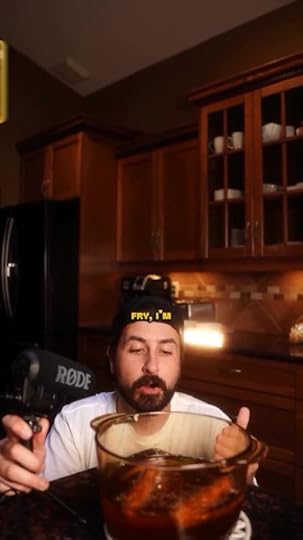
[image error] [image error] [image error] [image error]
[image error] [image error] [image error] [image error] [image error]
BEST: Deep-fried matcha green tea and strawberry Kitkats
WORST: Edamame ice cream
Our 13 Days of Halloween countdown continues with…I Saw the TV Glow
The director’s previous film was an obtuse contemplation of teen identity, mental health, and the online horror community. This movie approaches similar topics, as well as our connection to television, in the same detached, disconnected manner. One of those movies the avant-garde few will find meaningful while most others will dismiss as pointless
1.5/5 pumpkins
The post October 21, 2024: Recent Yes/No’s – Best and Worst! Plus the 13 Days of Halloween Countdown continues! appeared first on Joseph Mallozzi's Weblog.
October 20, 2024
October 19, 2024: Sharky Sunday! Plus the 13 Days of Halloween countdown continues with Trap!
October 17th was Sharky’s Gotcha Day! Hard to believe it’s been a year since adopted this little bear.

Taste-testing his new elk treats…

Out and About with this turkey tendon…

Out and About to Pet Value…

Out and About to Tiny Market…

Meanwhile, our 13 Days of Halloween countdown continues with….Trap!
A preposterous premise, cardboard characters (with the exception of an inspired performance by Jonathan Langdon as a beleaguered concession stand operator) doing ludicrous things to advance the contrived plot. The Sixth Sense seems so long ago.
2/5 Pumpkins
The post October 19, 2024: Sharky Sunday! Plus the 13 Days of Halloween countdown continues with Trap! appeared first on Joseph Mallozzi's Weblog.
October 19, 2024
October 19, 2024: The Twilight Zone rewatch continues with season 5, episodes 5-8! Plus our 13 Days of Halloween countdown begins with Longlegs!
Season 5, Episode 5, “Last Night of a Jockey”
This episode first aired October 25, 1963.
This episode features the smallest cast of any episode of The Twilight Zone.
Rod Serling wrote this script for actor Mickey Rooney who happened to be a friend. Said Serling: “I thought of Rooney, and then I tailored the story to fit him. (-) This is a brilliant actor. He is just great.”
The racing commission lawyer Grady speaks to over the phone is referred to as Mr. Newman. Joseph M. Newman was the director of this episode.
Three separate but more or less identical sets were created for this episode that was shot on Stage 19 at MGM.
Alas, season 5’s strong start stumbles in an episode that ultimately feels like a less interesting version of “Nervous Man in a Four Dollar Room”. Rooney is a little too over-the-top while Sterling’s script doesn’t really do him any favors.
Season 5, Episode 6, “Living Doll”
This episode first aired November 1, 1963.
June Foray, who voiced Rocky the Flying Squirrel in The Rocky and Bullwinkle Show, provided the voice of the “Talky Tina” doll. She was also the voice of Mattel’s “Chatty Cathy” doll, upon which “Talky Tina” was based. The doll itself was not custom-made but actually an existing doll, Brikette, made by the Vogue Doll Company.
According to The Twilight Zone Companion, this episode was written in one day by Jerry Sohl, even though credit was given entirely to Charles Beaumont. Sohl recalled: “I think Chuck Beaumont and I were walking along and saying “Suppose we had a doll that talked, and could answer our questions and reprimand us. Just think of all the things that doll could do!” Not anything animal or carnal, but in speaking. So we got on that track. It was no problem at all, once we had worked out the idea. A couple of months passed, and I said “Gee, it’s about time that I did Living doll” because Beaumont was in no condition to do it. I usually wrote most of Beaumont’s stuff at that stage of the game. He had some kind of illness. It was a good project and I really enjoyed it. I thought it turned out very well.”
The house set was later reused in Ring-A-Ding Girl (1963).
This episode inspired The Simpsons’ Treehouse of Horror segment “Clown without Pity”.
Actor Telly Savalas, who played dear dad in this episode, is perhaps best known for his portrayal of Kojak. His character was always sucking on a lollipop because Savalas used it as a trick to quit smoking.
Savalas was originally cast in the title role of Cool Hand Luke (1967) but ended up relinquishing the role to Paul Newman due to a scheduling conflict. Interestingly enough, Savalas wasn’t the first choice to play Kojak. Marlon Brando was offered the role but turned it down.
This was an absolute killer episode and presently ties “Nightmare at 20,000 Feet” forgets of this season. Top-notch performances and a delightfully creepy script by Jerry Sohl. I wondered how dark they would go and, boy, they went there.
Season 5, Episode 7, “The Old Man in the Cave”
This episode first aired November 8, 1963.
This episode was based on the short story, “The Old Man”, by Henry Slesar. Even though it was copyrighted in 1962, the story went unpublished until 1980.
The main character in this episode is named Goldsmith, after Jerry Goldsmith (father of Stargate composer Joel Goldsmith) who was one of the show’s composers.
This episode marked actor John Aderson’s fourth and final appearance on The Twilight Zone.
This one wasn’t bad and was helped by a terrific twist (the computer reveal) and the downbeat ending (the entire community pays the price for their rebellion). I thought it would have benefited with a little more insight into why the community members had decided to rebel given the old man’s suggestions had borne out correctly to date. Also didn’t really understand why the people were so outraged that they felt compelled to destroy the computer. And speaking of the computer, how the hell did it get up in that cave? It didn’t look very portable.
Season 5, Episode 8, “Uncle Simon”
This episode first aired November 15, 1963.
A slightly altered version of Forbidden Planet’s Robby the Robot makes an appearance in this episode. Robby was the most expensive prop built for the 1956 movie with a price tag of $125 000.
The entry hall and living room sets in this episode were previously used in season 4’s “Miniature”.
The entirety of the episode was shot on MGM’s Stage 18.
Actor Vic Perrins provides the voice of the robot.
Sponsor American Tobacco vetted the script and complained about Barbara’s line “Get rid of your ugly smelling pipe ashes”. They also objected to the scene in which Barbara sweeps the pipes and ashtray off Uncle Simon’s desk before angrily stamping on them. Serling noted the requests but made no changes to the script.
Boy, this one was a weird one. Uncle Simon was an outright asshole and I suppose as the episode progresses, you’re supposed to dislike Barbara as well and feel her comeuppance is well-deserved, but I simply felt sorry for her throughout. All the same, I did find it an enjoyable enough episode despite its inherent silliness.
Meanwhile, our 13 Days of Halloween countdown begins with…Longlegs.
The narrative pieces don’t fully come together in a heavily telegraphed ending that fails to deliver in either surprising or fully satisfying fashion but, boy oh boy, does Nic Cage deliver one hell of an unnervingly weird performance as the titular character.
3.5/5 Pumpkins
What did you all think?
Here’s the rest of the viewing schedule:
Saturday, October 19: Trap
Sunday, October 20: Stopmotion
Monday, October 21: I Saw the TV Glow
Tuesday, October 22: Cuckoo
Wednesday, October 23: Exhuma
Thursday, October 24: Strange Darling
Friday, October 25: Oddity
Saturday, October 26: The First Omen
Sunday, October 27: In Violent Nature
Monday, October 28: The Substance
Tuesday, October 29: Terrifier 3
Wednesday, October 30: Smile 2
The post October 19, 2024: The Twilight Zone rewatch continues with season 5, episodes 5-8! Plus our 13 Days of Halloween countdown begins with Longlegs! appeared first on Joseph Mallozzi's Weblog.
October 18, 2024
October 18, 2024: The Friday Report!
Today, we made a family trip to our favorite pasta place, Tiny Market Pasta Shop, for…what else?
House made san marzano tomato paste, tomato confit oil, tomato confit sauce, vodka passata & tomato salt topped with house made crème fraiche, oregano, breadcrumb & fresh ricotta.
Roasted sunchoke, caramelized fennel & chanterelle filled tortelli with miso butter, extra virgin olive oil, balsamic, chive, toasted black sesame & lemon zest.
Both pastas were heavenly, but this is one of those rare instances where Akemi actually preferred the stuffed pasta. So much so that we ended up doing a second order!
Finally, I’m kicking off a 13 Days of Halloween countdown with a screening of…
Longlegs
A horror movie a day until Halloween:
Saturday, October 19: Trap
Sunday, October 20: Stopmotion
Monday, October 21: I Saw the TV Glow
Tuesday, October 22: Cuckoo
Wednesday, October 23: Exhuma
Thursday, October 24: Strange Darling
Friday, October 25: Oddity
Saturday, October 26: The First Omen
Sunday, October 27: In Violent Nature
Monday, October 28: The Substance
Tuesday, October 29: Terrifier 3
Wednesday, October 30: Smile 2
The post October 18, 2024: The Friday Report! appeared first on Joseph Mallozzi's Weblog.
Joseph Mallozzi's Blog
- Joseph Mallozzi's profile
- 39 followers


